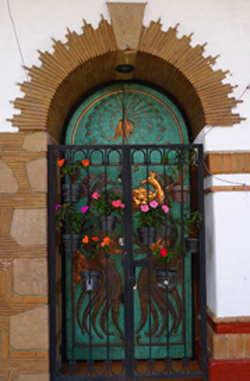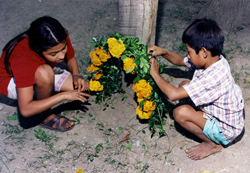Story and images by Bob Schulman
If you like things made out of copper, you’ll love the little village of Santa Clara del Cobre out in the western Mexican state of Michoacan.
Here, the cobbled streets are lined with hundreds of shops selling everything from copper jewelry to copper vases, pots and frying pans to huge copper bathtubs – all at stunningly low prices.
Where does all the copper come from? At one time there were copper mines around these parts, but they petered out long ago. After that, the town got the word out that it would buy all the scrapped copper it could get its hands on. Like old copper wiring, cables, pipes and tubes, rain gutters, roofs and even tossed out building domes and spires.
 Today, truckloads of the shiny metal pour into Santa Clara, much of it sent by electric companies around the country. On arrival, pieces of the scrapped metal are melted down into pure copper ingots, typically the size of a loaf of bread. Particular articles are then pounded into shape by teams of sweating guys taking turns whacking the red-hot ingots with sledge hammers. A single item, perhaps a large bowl, might be fired, hammered and dunked in tubs of water a dozen or more times before it’s finished.
Today, truckloads of the shiny metal pour into Santa Clara, much of it sent by electric companies around the country. On arrival, pieces of the scrapped metal are melted down into pure copper ingots, typically the size of a loaf of bread. Particular articles are then pounded into shape by teams of sweating guys taking turns whacking the red-hot ingots with sledge hammers. A single item, perhaps a large bowl, might be fired, hammered and dunked in tubs of water a dozen or more times before it’s finished.
 A spokesman at Casa Felicitas, one of the town’s largest craft shops, said the shaping process “can take as little as a day to as long as a month.” He said a copper sink, for example, takes three days to make.
A spokesman at Casa Felicitas, one of the town’s largest craft shops, said the shaping process “can take as little as a day to as long as a month.” He said a copper sink, for example, takes three days to make.
Just about everyone in this town of 10,000 people makes his or her living from the copper business in one way or another.
“Copper-smithing at Santa Clara has been going on for centuries,” says historian Jaime Capulli in Mexico City. “In pre-Hispanic times (before 1519) the native Purepechas were the tough kids on the block because this area was one of the few spots with the ore needed to make metal weapons.”
Santa Clara del Cobre, named for St. Claire (the town’s patron saint) and the Spanish word for copper, was founded in 1553. Its heritage, culture and colonial ambiance helped the city qualify as one of 57 pueblos magicos (magic cities) across Mexico.
 Tours of the region typically operate from the state capital at Moralia, from which it’s about an hour’s drive to Santa Clara. Among other craft villages on the tour routes are Uruapan (known for its lacquerware), Tzintzuntzan (pottery), Cuanajo (furniture), Paracho (guitars) and Patzcuaro (the region’s main marketplace).
Tours of the region typically operate from the state capital at Moralia, from which it’s about an hour’s drive to Santa Clara. Among other craft villages on the tour routes are Uruapan (known for its lacquerware), Tzintzuntzan (pottery), Cuanajo (furniture), Paracho (guitars) and Patzcuaro (the region’s main marketplace).
Getting there: Copper shoppers can fly to Morelia from U.S. hubs such as Dallas/Ft. Worth and Houston, then either join a tour or rent a car for the trip to Santa Clara. Purchased goods can be hauled back to the airport at Morelia to be flown home, or shipped directly from Santa Clara.
Staying there: Serious shoppers can opt to spend the night at a handful of tourist-class hotels around Santa Clara including the Camino Real and the Cabanas Mi Betania. Another solution is to stay over in Moralia, where visitors have a choice of a dozen or so upscale boutique hotels in the city’s colonial district or at the award-winning Villa Montana (www.villamontana.com.mx) on a hillside overlooking the town.


